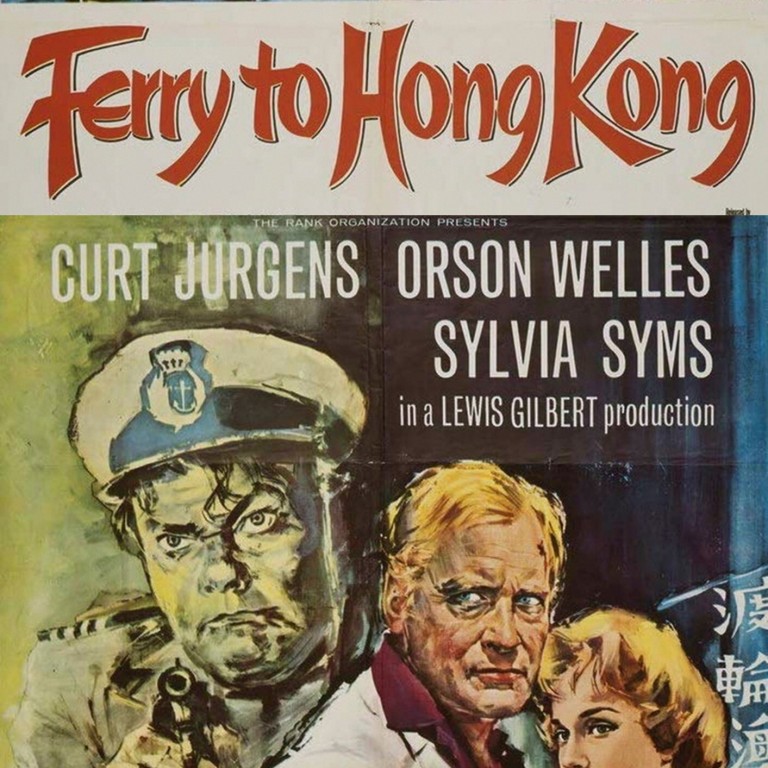
Ferry to Hong Kong: the 1959 film about a stateless passenger who spent 10 months aboard the Lee Hong
- Directed by Lewis Gilbert, the movie tells the real-life tale of Steven Ragan, a drifter who was stuck sailing between Hong Kong and Macau
- Gilbert later brought another international man of mystery, James Bond, to Hong Kong in You Only Live Twice, The Spy Who Loved Me and Moonraker
The much-anticipated Ferry to Hong Kong opened at two local cinemas – the Lee Theatre, in Causeway Bay, and the Astor, in Yau Ma Tei – on New Year’s Eve 1959. Filmed entirely on location in Hong Kong and Macau that same year, the “much discussed comedy-drama” was described by reviewer Anthony Fuller in The China Mail as “rich fare. It has colour, glamour, romance, high tragedy, comedy, and drama”.
Six months earlier, after its premiere in London, reviews had been less positive, and Orson Welles’ horribly hammy performance was universally panned. “By outrageously parodying the part of the ferry boat’s skipper,” wrote one London critic, Welles “forfeits our belief in the reality of the entire vessel, its passengers, its crew”.
The film’s main character (well played by Curt Jurgens) is a stateless drifter, stuck on the Hong Kong-Macau ferry with no passport, and was based on a real person, named Steven Ragan. His unusual, long-forgotten story – which was keenly reported by the international press in 1952-53 – was fictionalised in a novel called Ferry to Hongkong by English writer Max Catto (using the pseudonym Simon Kent) in 1957, and the film was based on that book.
Ragan (aka Michael Patrick O’Brien) spent more than 10 months aboard the Lee Hong, enduring the eight-hour round trip daily, except for a brief spell in dry dock in Hong Kong, from September 18, 1952 to July 30, 1953. On July 31, The New York Times reported that he had clocked up 23,680 miles (38,109km) before being finally allowed by immigration authorities to disembark in Hong Kong for a flight out of Kai Tak airport to Rome, Italy.
American hotel and resort chains new hygiene regimes

American hotel and resort chains have been ramping up their hygiene protocols and procedures at properties around the world in recent weeks, and labelling them with a squeaky-clean-sounding range of trademarks, brands and titles.
Some, such as Radisson Hotel Group’s “Radisson Hotels Safety Protocol”, are straightforward enough. Then there are catchier, folksier new offerings, like Best Western’s “We Care Clean” and Wyndham Hotels & Resorts’ “Count on Us” (promoted by a very dependable looking couple).
Hilton is “defining a new standard of hotel cleanliness” with “Hilton CleanStay”, which is co-branded as “CleanStay with Lysol Protection” in North America. Choice Hotels is demonstrating how committed it is with a “Commitment to Clean” initiative, as is Hyatt, with the grander-sounding “Global Care & Cleanliness Commitment”.
Perhaps most grandiose, though, is Marriott’s “Global Cleanliness Council”, which has brought on board scientists, doctors and other specialists to help “meet the new health and safety challenges presented by the current pandemic environment”.
Tiki cocktails promise ‘the dream of escape’

Tiki cocktails such as the mai tai, pearl diver and zombie are as likely to evoke Trader Vic’s, in the London Hilton on Park Lane, as the South Pacific, but a new book of recipes promises “the dream of escape, a tropical vacation complete with warm ocean water, island music, and beachside dinners”.
As well as looking at the 1930s origins of the Tiki movement, from founding fathers Don the Beachcomber and Trader Vic, Easy Tiki, by Chloe Frechette, offers 20 classic and 40 modern cocktail recipes, styling tips and even instructions on how to build a Tiki bar at home. With the encouraging invitation to “enjoy the island life – wherever you are”, it’s available in Kindle format from Amazon for
US$9.99. For a more globally themed home bar-crawl, try Around the World in 80 Cocktails, written by Chad Parkhill with illustrations by Alice Oehr. It’s available only in hard cover, but much of it – recipes included – can be previewed at Amazon.

